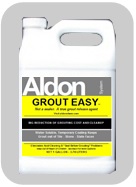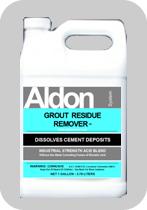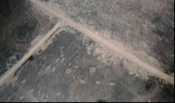Home | Surface Types | Problem Solving | Products | Prices & Ordering
HOW TO CLEAN GROUT RESIDUE STAINS FROM THE SURFACING FACESection 1:
This first section discusses the usual cement based residue (grayish haze or smears) left behind from the grouting process. This includes also the dust and drips from cutting concrete slabs and concrete productsSee Section 2 for the following issues that are not cement based residue:
- Colored grout - the pigment has come out of the colored grout and remains on the face of the surfacing.
- Grout with additives (acrylic, latex, polymer, etc.) and the additives remain on the face of surfacing.
- Epoxy grout
If the installer has NOT used
to protect the surface prior to grouting, you now have anything from a light hazy appearance to actual heavy deposits of grout on the surfacing face. Here is the product you will need now: 

Video: See "Grout Residue Remover" at work!
Grout stains are a bit easier to remove when fresh and the cement is not very hard, however, even years later they will be eaten off by "Grout Residue Remover".
Here is a slate installation that shows typical grout residue stains. 
This is obviously not the look you anticipated. Sealers do not improve this situation and in fact will sometimes magnify all visual characteristics of the surface, both good and bad.
Note that grout residue will be grayish in color (or the color of the grout) and efflorescence is a whitish, powdery look. Grout residue will appear where the grout was smeared on the material face. Efflorescence can be in the same areas, as well as any other area. See the "efflorescence" page in this section.
DO NOT USE MURIATIC ACID! There is a much better, safer alternative.
Muriatic acid is the most common way installers clean grout residue from the tile and they have been doing it for years. Used outdoors, the risks are far less, but indoors the risks are considerable. Dilutions of the acid do not prevent the conditions described below. Remember, you have to live with the possible side effects. They are:
- Muriatic acid generates invisible fumes that are not only potentially harmful to people, they can create small rust spots and eventually corrode metal parts of fixtures and decor. Once this begins you can't stop it and the damage can be enormous.
- Muriatic acid will penetrate into tile and grout and dry out leaving behind minute acid crystals. These crystals will react with moisture in the air and mop water to reactivate and produce undetectable fumes. As all sealers must breathe out water vapor, a sealer will not stop this process and these fumes over time will cause the rust effect described above.
These crystals can also react with some liquid sealers and cause white spotting, peeling, and/or premature curing.- Unless muriatic acid is applied very carefully the cement bond in the grout can be broken down. The result is grout that "powders" out of the joint.
- The overuse of muriatic acid can bleach the color from some types of surfacing. If this occurs, test a sample of one of our "color enhancing" sealers because if may restore the color. See Surface Type for the options.
Aldon "Grout Residue Remover" has the cleaning power of muriatic acid, but inhibits and suppresses any negative characteristics.

Section 2: non-cement based stains:
If you find that some or all of the smears from grouting are not removed with a fizzing reaction when "Grout Residue Remover / Brick & Block Cleaner" is applied, the remaining smears are not the cement part of the grout. It is likely to be one of the following conditions:
- Colored grout - the pigment has come out of the colored grout and remains on the face of the surfacing. Test lacquer thinner to see if it will break away the pigment and float it so that it can be blotted up into a clean white cloth.
- Additive bleedout from additives in the grout: If the grout is termed "poly", "modified", "acrylic modified", "additive", etc. it will contain an acrylic, latex, or other additive to enhance its performance. It is cleaned in the identical manner, except, any residual stains that do not fizz on contact with "Grout Residue Remover / Brick & Block Cleaner" are an additive that requires Aldon "Premium Stripper" to melt it.

- Epoxy grout does not contain cement and requires Premium Stripper to break it down. - see the epoxy grout page in "Problem Solving".
Comparisons of various acidic cleaners
- Vinegar
- weakest - only for light grout haze - can leave an oily type residue with rainbow color reflections.
- Sulfamic Acid and Citric Acid
- fairly weak - safe - takes a lot of time and effort
- More of the results come from the scrubbing then the chemicals
- Phosphoric Acid base
- stronger - safe in the Aldon "Grout Restoration" formulation
- Muriatic Acid
- very strong - dangerous - harmful to metal surfaces and health
(Use Aldon "Grout Residue Remover / Brick & Block Cleaner" to get this strength without the problems. Anything stronger than "Grout Residue Remover / Brick & Block Cleaner" is too strong to use safely and may be harmful to surfaces and people.)